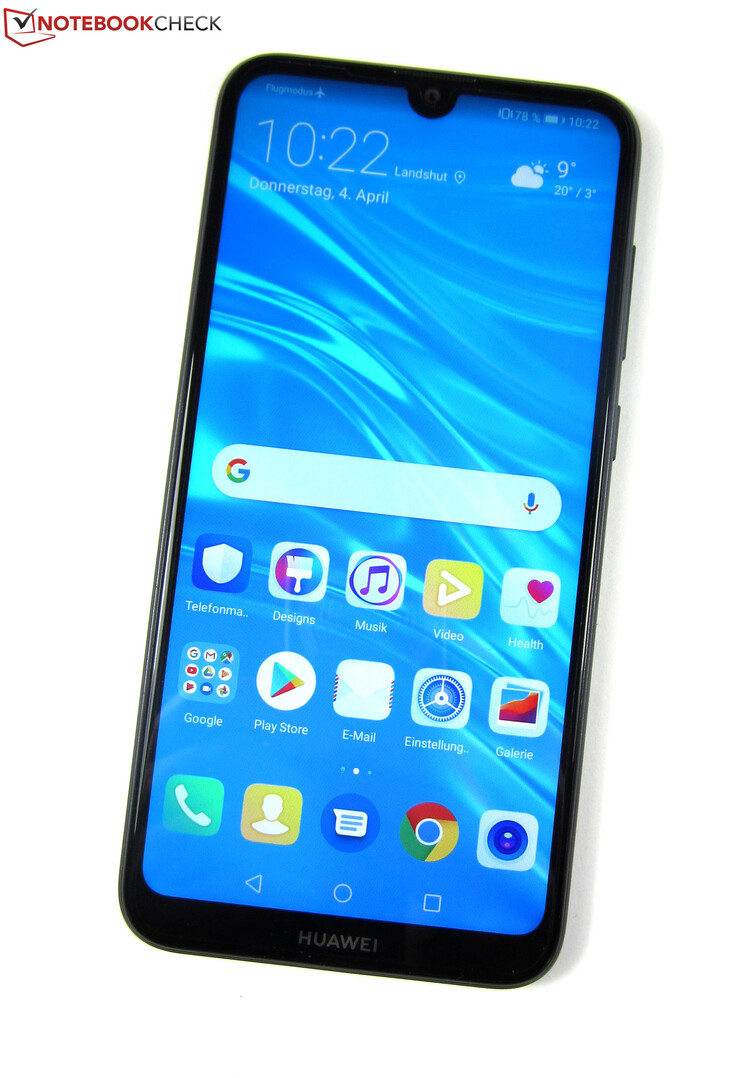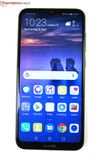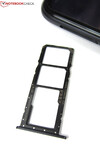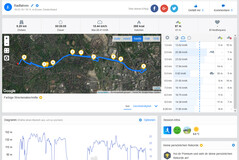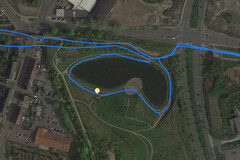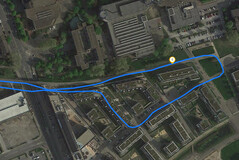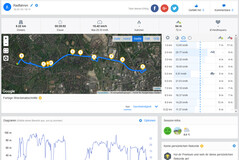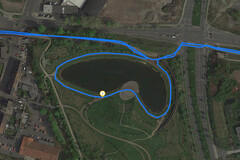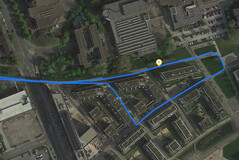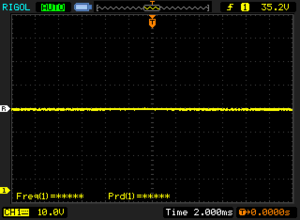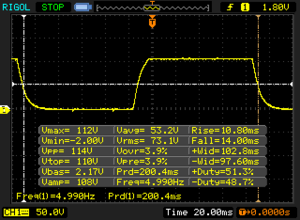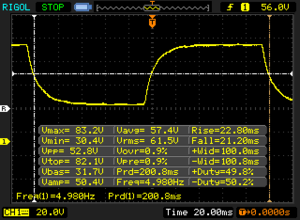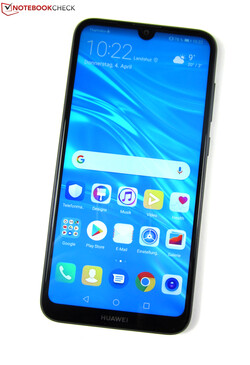Breve Análise do Smartphone Huawei Y7 2019
Os Top 10
» Os Top 10 Portáteis Multimídia
» Os Top 10 Portáteis de Jogos
» Os Top 10 Portáteis Leves para Jogos
» Os Top 10 Portáteis Acessíveis de Escritório/Empresariais
» Os Top 10 Portáteis Premium de Escritório/Empresariais
» Os Top 10 dos Portáteis Workstation
» Os Top 10 Subportáteis
» Os Top 10 Ultrabooks
» Os Top 10 Conversíveis
» Os Top 10 Tablets
» Os Top 10 Smartphones
» A melhores Telas de Portáteis Analisadas Pela Notebookcheck
» Top 10 dos portáteis abaixo dos 500 Euros da Notebookcheck
» Top 10 dos Portáteis abaixo dos 300 Euros
| |||||||||||||||||||||||||
iluminação: 94 %
iluminação com acumulador: 547 cd/m²
Contraste: 1116:1 (Preto: 0.49 cd/m²)
ΔE ColorChecker Calman: 4.5 | ∀{0.5-29.43 Ø4.78}
ΔE Greyscale Calman: 5 | ∀{0.09-98 Ø5}
93% sRGB (Calman 2D)
Gamma: 2.35
CCT: 7400 K
| Huawei Y7 2019 IPS, 1520x720, 6.3" | Huawei P20 Lite IPS, 2280x1080, 5.8" | Huawei Y7 2018 IPS, 1440x720, 6" | Motorola Moto G7 Play IPS, 1512x720, 5.7" | Nokia 3.1 Plus IPS, 1440x720, 6" | Samsung Galaxy A6 Plus 2018 Super AMOLED, 2220x1080, 6" | Xiaomi Mi 8 Lite IPS, 2280x1080, 6.3" | |
|---|---|---|---|---|---|---|---|
| Screen | -8% | -3% | -5% | 16% | 29% | 7% | |
| Brightness middle (cd/m²) | 547 | 528 -3% | 393 -28% | 479 -12% | 526 -4% | 519 -5% | 421 -23% |
| Brightness (cd/m²) | 543 | 525 -3% | 365 -33% | 481 -11% | 510 -6% | 513 -6% | 389 -28% |
| Brightness Distribution (%) | 94 | 89 -5% | 85 -10% | 94 0% | 94 0% | 93 -1% | 85 -10% |
| Black Level * (cd/m²) | 0.49 | 0.51 -4% | 0.29 41% | 0.37 24% | 0.17 65% | 0.33 33% | |
| Contrast (:1) | 1116 | 1035 -7% | 1355 21% | 1295 16% | 3094 177% | 1276 14% | |
| Colorchecker dE 2000 * | 4.5 | 4.7 -4% | 5.28 -17% | 4.91 -9% | 6.64 -48% | 1.8 60% | 3.4 24% |
| Colorchecker dE 2000 max. * | 7.9 | 8.9 -13% | 9 -14% | 9.47 -20% | 10.02 -27% | 3.6 54% | 5.9 25% |
| Greyscale dE 2000 * | 5 | 6.4 -28% | 4.2 16% | 6.4 -28% | 6.4 -28% | 1.5 70% | 3.9 22% |
| Gamma | 2.35 94% | 2.22 99% | 2.6 85% | 2.108 104% | 2.344 94% | 2.06 107% | 2.26 97% |
| CCT | 7400 88% | 7987 81% | 7086 92% | 7292 89% | 7989 81% | 6462 101% | 7330 89% |
* ... menor é melhor
Cintilação da tela / PWM (modulação por largura de pulso)
| Tela tremeluzindo / PWM não detectado | |||
[pwm_comparison] Em comparação: 53 % de todos os dispositivos testados não usam PWM para escurecer a tela. Se PWM foi detectado, uma média de 8118 (mínimo: 5 - máximo: 343500) Hz foi medida. | |||
Exibir tempos de resposta
| ↔ Tempo de resposta preto para branco | ||
|---|---|---|
| 24.8 ms ... ascensão ↗ e queda ↘ combinadas | ↗ 10.8 ms ascensão | |
| ↘ 14 ms queda | ||
| A tela mostra boas taxas de resposta em nossos testes, mas pode ser muito lenta para jogadores competitivos. Em comparação, todos os dispositivos testados variam de 0.1 (mínimo) a 240 (máximo) ms. » 57 % de todos os dispositivos são melhores. Isso significa que o tempo de resposta medido é pior que a média de todos os dispositivos testados (20.2 ms). | ||
| ↔ Tempo de resposta 50% cinza a 80% cinza | ||
| 44 ms ... ascensão ↗ e queda ↘ combinadas | ↗ 22.8 ms ascensão | |
| ↘ 21.2 ms queda | ||
| A tela mostra taxas de resposta lentas em nossos testes e será insatisfatória para os jogadores. Em comparação, todos os dispositivos testados variam de 0.165 (mínimo) a 636 (máximo) ms. » 72 % de todos os dispositivos são melhores. Isso significa que o tempo de resposta medido é pior que a média de todos os dispositivos testados (31.6 ms). | ||
| JetStream 1.1 - Total Score | |
| Xiaomi Mi 8 Lite (Chrome 71) | |
| Motorola Moto G7 Play | |
| Nokia 3.1 Plus (Chrome 71) | |
| Huawei P20 Lite (Chrome 63) | |
| Média Qualcomm Snapdragon 450 (22 - 22.7, n=13) | |
| Samsung Galaxy A6 Plus 2018 (Chrome 67) | |
| Huawei Y7 2018 (Chrome 66) | |
| Octane V2 - Total Score | |
| Média da turma Smartphone (2228 - 121337, n=200, últimos 2 anos) | |
| Xiaomi Mi 8 Lite (Chrome 71) | |
| Motorola Moto G7 Play | |
| Nokia 3.1 Plus (Chrome 71) | |
| Huawei P20 Lite | |
| Huawei Y7 2019 (Chrome 73.0.3683.90) | |
| Samsung Galaxy A6 Plus 2018 (Chrome 67) | |
| Média Qualcomm Snapdragon 450 (3470 - 4115, n=14) | |
| Huawei Y7 2018 (Chrome 66) | |
| Mozilla Kraken 1.1 - Total | |
| Huawei Y7 2018 (Chrome 66) | |
| Média Qualcomm Snapdragon 450 (11012 - 11863, n=14) | |
| Samsung Galaxy A6 Plus 2018 (Chrome 67) | |
| Huawei Y7 2019 (Chrome 73.0.3683.90) | |
| Nokia 3.1 Plus (Chrome 71) | |
| Huawei P20 Lite (Chrome 63) | |
| Motorola Moto G7 Play | |
| Xiaomi Mi 8 Lite (Chrome 71) | |
| Média da turma Smartphone (257 - 28190, n=155, últimos 2 anos) | |
| WebXPRT 3 - Overall | |
| Média da turma Smartphone (38 - 380, n=35, últimos 2 anos) | |
| Xiaomi Mi 8 Lite (Chrome 71) | |
| Huawei P20 Lite (Chrome 63) | |
| Huawei Y7 2019 (Chrome 73.0.3683.90) | |
| Samsung Galaxy A6 Plus 2018 | |
| Média Qualcomm Snapdragon 450 (28 - 34, n=8) | |
| Huawei Y7 2018 (Chrome 66) | |
| WebXPRT 2015 - Overall | |
| Xiaomi Mi 8 Lite (Chrome 71) | |
| Huawei Y7 2019 (Chrome 73.0.3683.90) | |
| Média Qualcomm Snapdragon 450 (90 - 103, n=7) | |
| Samsung Galaxy A6 Plus 2018 (Chrome 67) | |
| Huawei P20 Lite (Chrome 63) | |
| Huawei Y7 2018 (Chrome 66) | |
* ... menor é melhor
| Huawei Y7 2019 | Huawei P20 Lite | Huawei Y7 2018 | Motorola Moto G7 Play | Nokia 3.1 Plus | Samsung Galaxy A6 Plus 2018 | Xiaomi Mi 8 Lite | Média 32 GB eMMC Flash | Média da turma Smartphone | |
|---|---|---|---|---|---|---|---|---|---|
| AndroBench 3-5 | 64% | -24% | 54% | -30% | -4% | 15% | -11% | 1167% | |
| Sequential Read 256KB (MB/s) | 305 | 293.9 -4% | 256 -16% | 289 -5% | 272.5 -11% | 298.8 -2% | 282.6 -7% | 242 ? -21% | 2223 ? 629% |
| Sequential Write 256KB (MB/s) | 88.8 | 198.3 123% | 71.5 -19% | 111 25% | 35.72 -60% | 88.5 0% | 172.4 94% | 100.5 ? 13% | 1838 ? 1970% |
| Random Read 4KB (MB/s) | 83.5 | 48.19 -42% | 38.8 -54% | 74 -11% | 52.4 -37% | 72.9 -13% | 81.3 -3% | 43.1 ? -48% | 295 ? 253% |
| Random Write 4KB (MB/s) | 17.48 | 71.1 307% | 9.5 -46% | 73 318% | 8.33 -52% | 16.1 -8% | 18.75 7% | 22.3 ? 28% | 335 ? 1816% |
| Sequential Read 256KB SDCard (MB/s) | 86.4 ? | 83.5 ? -3% | 85 -2% | 84.7 ? -2% | 81.3 ? -6% | 83.4 ? -3% | 85.9 ? -1% | 71.8 ? -17% | |
| Sequential Write 256KB SDCard (MB/s) | 65.8 ? | 69 ? 5% | 61.5 -7% | 64.1 ? -3% | 55.2 ? -16% | 67.8 ? 3% | 64 ? -3% | 52.9 ? -20% |
Dead Trigger 2
Arena of Valor
(+) A temperatura máxima no lado superior é 37.8 °C / 100 F, em comparação com a média de 35.2 °C / 95 F , variando de 21.9 a 247 °C para a classe Smartphone.
(+) A parte inferior aquece até um máximo de 34 °C / 93 F, em comparação com a média de 34 °C / 93 F
(±) Em uso inativo, a temperatura média para o lado superior é 33.7 °C / 93 F, em comparação com a média do dispositivo de 32.9 °C / ### class_avg_f### F.
Huawei Y7 2019 análise de áudio
(+) | os alto-falantes podem tocar relativamente alto (###valor### dB)
Graves 100 - 315Hz
(-) | quase nenhum baixo - em média 31.6% menor que a mediana
(±) | a linearidade dos graves é média (10.9% delta para a frequência anterior)
Médios 400 - 2.000 Hz
(+) | médios equilibrados - apenas 4.6% longe da mediana
(+) | médios são lineares (6.9% delta para frequência anterior)
Altos 2 - 16 kHz
(±) | máximos mais altos - em média 6.9% maior que a mediana
(±) | a linearidade dos máximos é média (7.6% delta para frequência anterior)
Geral 100 - 16.000 Hz
(±) | a linearidade do som geral é média (25.5% diferença em relação à mediana)
Comparado com a mesma classe
» 63% de todos os dispositivos testados nesta classe foram melhores, 7% semelhantes, 30% piores
» O melhor teve um delta de 11%, a média foi 35%, o pior foi 134%
Comparado com todos os dispositivos testados
» 78% de todos os dispositivos testados foram melhores, 5% semelhantes, 18% piores
» O melhor teve um delta de 4%, a média foi 24%, o pior foi 134%
Huawei Y7 2018 análise de áudio
(±) | o volume do alto-falante é médio, mas bom (###valor### dB)
Graves 100 - 315Hz
(-) | quase nenhum baixo - em média 30.7% menor que a mediana
(±) | a linearidade dos graves é média (8.2% delta para a frequência anterior)
Médios 400 - 2.000 Hz
(±) | médios mais altos - em média 7.3% maior que a mediana
(±) | a linearidade dos médios é média (7.9% delta para frequência anterior)
Altos 2 - 16 kHz
(±) | máximos mais altos - em média 9% maior que a mediana
(+) | os máximos são lineares (5.9% delta da frequência anterior)
Geral 100 - 16.000 Hz
(-) | o som geral não é linear (33.7% diferença em relação à mediana)
Comparado com a mesma classe
» 84% de todos os dispositivos testados nesta classe foram melhores, 1% semelhantes, 15% piores
» O melhor teve um delta de 11%, a média foi 35%, o pior foi 134%
Comparado com todos os dispositivos testados
» 92% de todos os dispositivos testados foram melhores, 1% semelhantes, 6% piores
» O melhor teve um delta de 4%, a média foi 24%, o pior foi 134%
| desligado | |
| Ocioso | |
| Carga |
|
Key:
min: | |
| Huawei Y7 2019 4000 mAh | Huawei P20 Lite 3000 mAh | Huawei Y7 2018 3000 mAh | Motorola Moto G7 Play 3000 mAh | Nokia 3.1 Plus 3500 mAh | Samsung Galaxy A6 Plus 2018 3500 mAh | Xiaomi Mi 8 Lite 3350 mAh | Média Qualcomm Snapdragon 450 | Média da turma Smartphone | |
|---|---|---|---|---|---|---|---|---|---|
| Power Consumption | -35% | -38% | -42% | -47% | 28% | -37% | -34% | -63% | |
| Idle Minimum * (Watt) | 0.51 | 0.98 -92% | 0.9 -76% | 1 -96% | 1 -96% | 0.62 -22% | 0.56 -10% | 0.794 ? -56% | 0.848 ? -66% |
| Idle Average * (Watt) | 1.7 | 2 -18% | 1.9 -12% | 1.7 -0% | 2.4 -41% | 0.96 44% | 1.99 -17% | 2.27 ? -34% | 1.435 ? 16% |
| Idle Maximum * (Watt) | 1.85 | 2.11 -14% | 2.3 -24% | 2.6 -41% | 2.9 -57% | 0.99 46% | 2.05 -11% | 2.48 ? -34% | 1.621 ? 12% |
| Load Average * (Watt) | 3.17 | 3.9 -23% | 4.7 -48% | 4.1 -29% | 3.7 -17% | 1.85 42% | 4.62 -46% | 3.95 ? -25% | 6.99 ? -121% |
| Load Maximum * (Watt) | 4.44 | 5.62 -27% | 5.7 -28% | 6.5 -46% | 5.5 -24% | 3.04 32% | 8.94 -101% | 5.38 ? -21% | 11.3 ? -155% |
* ... menor é melhor
| Huawei Y7 2019 4000 mAh | Huawei P20 Lite 3000 mAh | Huawei Y7 2018 3000 mAh | Motorola Moto G7 Play 3000 mAh | Nokia 3.1 Plus 3500 mAh | Samsung Galaxy A6 Plus 2018 3500 mAh | Xiaomi Mi 8 Lite 3350 mAh | |
|---|---|---|---|---|---|---|---|
| Duração da bateria | -46% | -33% | -38% | -18% | -9% | -40% | |
| Reader / Idle (h) | 39.2 | 12.5 -68% | 21.8 -44% | 30.3 -23% | 28 -29% | ||
| H.264 (h) | 15.6 | 7.8 -50% | 11.5 -26% | 15.3 -2% | 11 -29% | ||
| WiFi v1.3 (h) | 18.6 | 9.7 -48% | 10.4 -44% | 11.5 -38% | 15.3 -18% | 14.1 -24% | 9.1 -51% |
| Load (h) | 4.9 | 4.1 -16% | 4.1 -16% | 5.6 14% | 2.5 -49% |
Pro
Contra
O Huawei Y7 2019 é uma atualização triunfante sobre o Y7 2018. O fabricante chinês melhorou em quase todas as áreas importantes, incluindo design, tela, desempenho e duração da bateria. Seus marcos estreitos e painel IPS de 6,26 polegadas também fazem o Y7 2019 parecer mais caro do que é.
A combinação de 3 GB de RAM, 32 GB de espaço de armazenamento e um SoC Snapdragon 450 da Qualcomm é decente, também para um dispositivo de nível de entrada. Existem dispositivos que oferecem melhor desempenho pelo mesmo preço, mas poucos também têm câmeras decentes, funcionalidade real de dois cartões SIM e microSD, além de uma fantástica duração da bateria.
O Huawei Y7 2019 é um excelente valor pelo dinheiro. Poucos smartphones de nível de entrada oferecem tanto quanto o Y7 2019.
Claro, a Huawei comprometeu algumas áreas para manter os custos baixos. A resolução de 720p é decepcionante, assim como a falta de NFC e a inclusão de uma porta micro USB ao invés de Type-C. O Motorola Moto G7 Play e o Xiaomi Mi 8 Lite oferecem melhor desempenho, enquanto o Samsung Galaxy A6 Plus (2018) também seria uma alternativa sólida e tem NFC. No entanto, a Huawei acertou muito com o Y7 2019, e suas deficiências não devem prejudicar o que é um excelente smartphone de nível de entrada.
Huawei Y7 2019
- 10/31/2019 v7 (old)
Manuel Masiero




